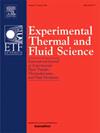Development of an advanced MEMS sensor for the simultaneous measurement of ion current and heat flux during flame–wall interactions
IF 2.8
2区 工程技术
Q2 ENGINEERING, MECHANICAL
Experimental Thermal and Fluid Science
Pub Date : 2025-01-27
DOI:10.1016/j.expthermflusci.2025.111422
引用次数: 0
Abstract
Flame–wall interactions have been extensively investigated using optical diagnostic techniques or numerical simulations. However, these techniques tend to be costly and complex, making their application to actual combustor challenging. Therefore, a measurement technique that is easy to use and applicable to practical systems is required. In this study, a thin-film sensor for the simultaneous measurements of ion current and heat flux was developed using the micro-electro-mechanical systems (MEMS) technology. The MEMS sensor comprised two ion current sensors and a resistance temperature detector for evaluating flame behaviors and heat transfer during transient flame–wall interactions. The MEMS sensor was tested under a head-on quenching condition. Consequently, the ion current and heat flux were clearly measured. Compared with the flame images recorded by a high-speed camera, the ion current began to rise when the flame entered the flame-detectable zone (approximately 600 μm in this study) of the sensor and reached its peak when the flame was closest to the sensor. Subsequently, the ion current began to decrease and finally disappeared when the flame was completely quenched. In addition, the ion current and heat flux showed dispersions in their peak values and phases. Through the validation using simple numerical simulations, the reason for the dispersions was presumed to be the local heat release rate. The MEMS sensor detected the local ion current and heat flux. Therefore, it can be used to evaluate the near-wall characteristics of flame behaviors and heat transfer during flame–wall interactions.
开发一种先进的MEMS传感器,用于同时测量火焰-壁相互作用过程中的离子电流和热流
使用光学诊断技术或数值模拟广泛研究了火墙相互作用。然而,这些技术往往是昂贵和复杂的,使其应用于实际燃烧器具有挑战性。因此,需要一种易于使用并适用于实际系统的测量技术。在这项研究中,利用微机电系统(MEMS)技术开发了一种用于同时测量离子电流和热流的薄膜传感器。MEMS传感器由两个离子电流传感器和一个电阻温度检测器组成,用于评估瞬态火焰-壁面相互作用过程中的火焰行为和传热。在正面淬火条件下对MEMS传感器进行了测试。因此,离子电流和热流被清楚地测量出来。与高速摄像机记录的火焰图像相比,当火焰进入传感器的火焰可探测区域(本研究中约为600 μm)时,离子电流开始上升,并在火焰最靠近传感器时达到峰值。随后,离子流开始减小,最终在火焰完全熄灭时消失。此外,离子电流和热流在峰值和相位上都表现出分散性。通过简单的数值模拟验证,推测分散的原因是局部放热速率。MEMS传感器检测局部离子电流和热流。因此,它可用于评价火焰-壁面相互作用过程中火焰行为和传热的近壁特性。
本文章由计算机程序翻译,如有差异,请以英文原文为准。
求助全文
约1分钟内获得全文
求助全文
来源期刊

Experimental Thermal and Fluid Science
工程技术-工程:机械
CiteScore
6.70
自引率
3.10%
发文量
159
审稿时长
34 days
期刊介绍:
Experimental Thermal and Fluid Science provides a forum for research emphasizing experimental work that enhances fundamental understanding of heat transfer, thermodynamics, and fluid mechanics. In addition to the principal areas of research, the journal covers research results in related fields, including combined heat and mass transfer, flows with phase transition, micro- and nano-scale systems, multiphase flow, combustion, radiative transfer, porous media, cryogenics, turbulence, and novel experimental techniques.
 求助内容:
求助内容: 应助结果提醒方式:
应助结果提醒方式:


